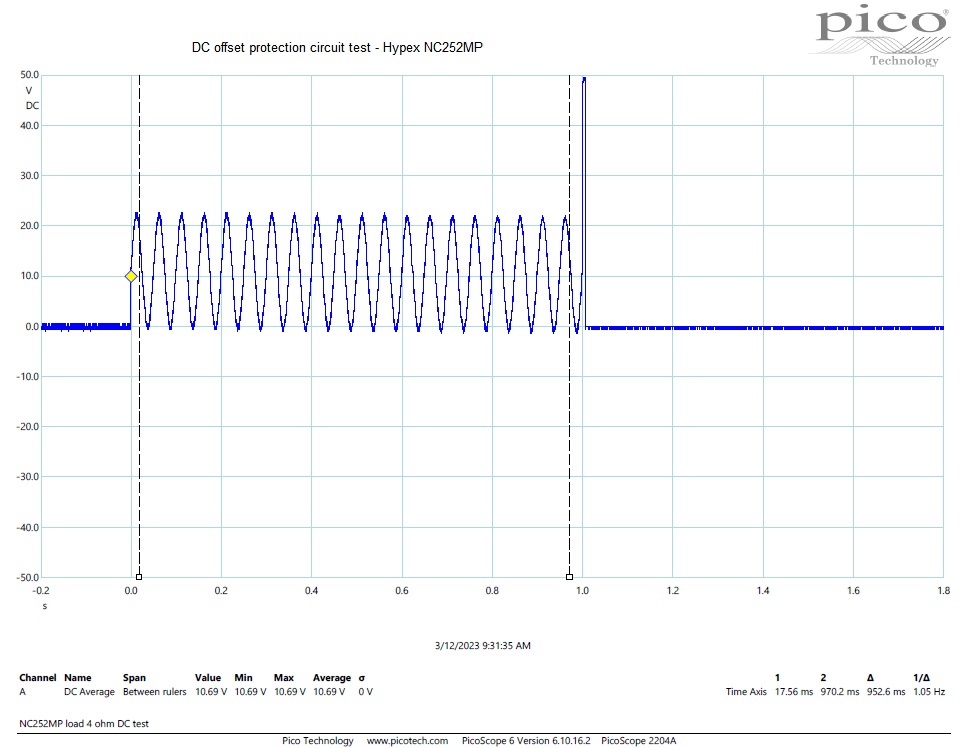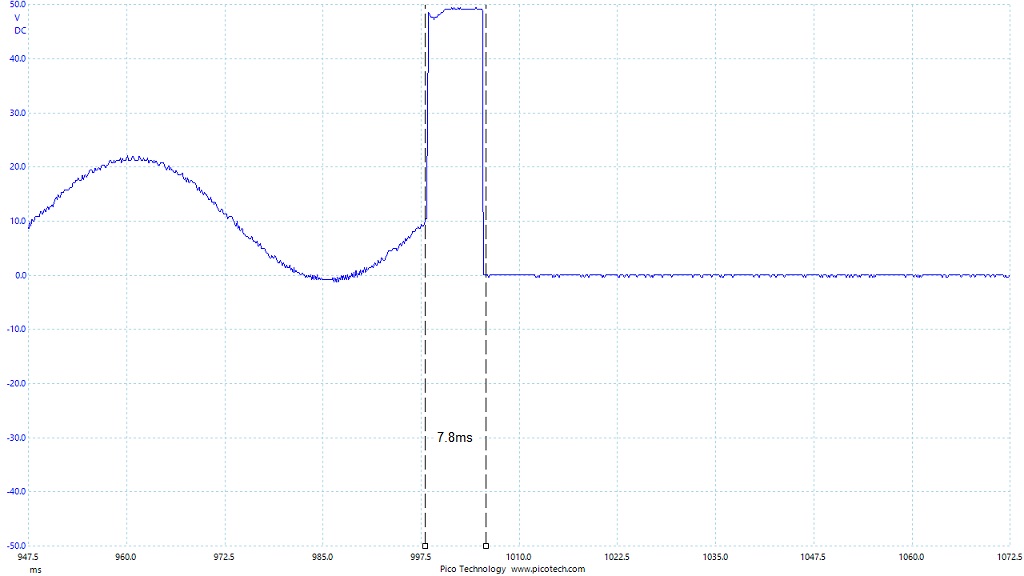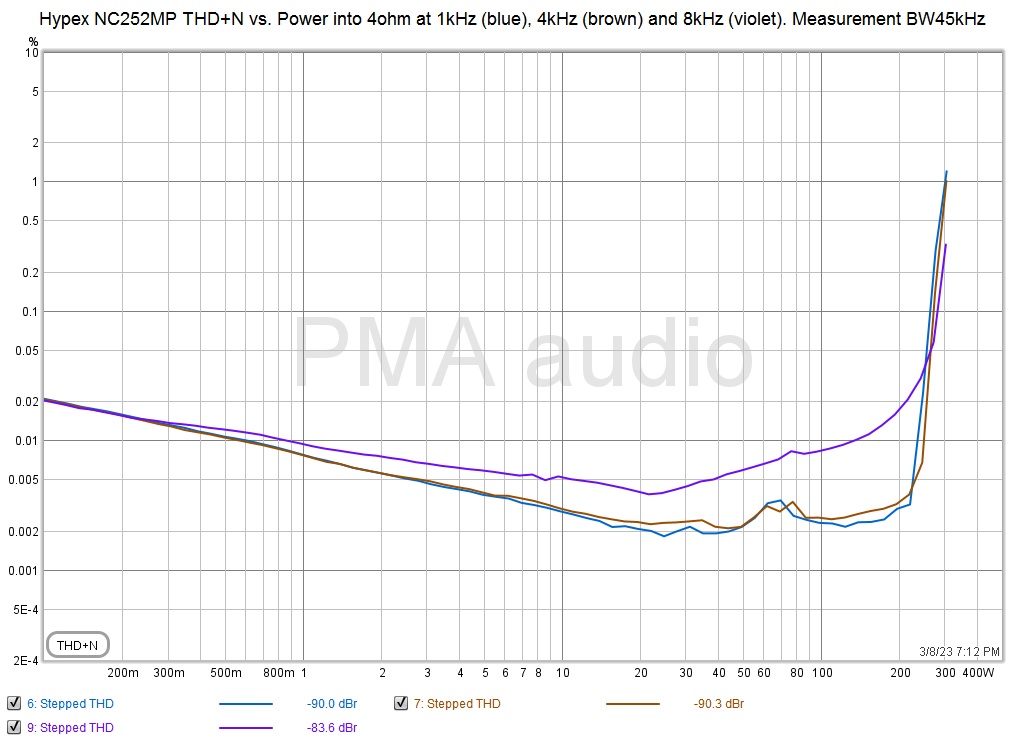
PMA-NC252MP power amplifier
1. Introduction
As a manufacturer of electronic equipment I have been granted a web account for Hypex OEM web shop. My newly designed power amplifier based on Hypex NCore modules is PMA NC252MP, amplifier with rated power 2x200W/4ohm and based on the NC252MP OEM modules.

2. Hypex NC252MP OEM module
The NC252MP amplifier module incorporates
a low power standby power supply (meets 2013 ERP Lot 6 0.5W
requirements), a highly efficient switch mode power supply and a
high-performance Class D amplifier in one compact and easily
applicable power brick.
The amplifier used in the NC252MP is a
self-contained high-performance class D amplifier intended for a
wide range of audio applications, ranging from public address
systems to ultrahigh-fidelity replay systems for studio and home
use. Chief distinguishing features are flat frequency response
irrespective of load impedance, nearly frequency independent
distortion behavior and very low radiated and conducted EMI.
Control is based on a phase shift controlled self-oscillating
loop taking feedback only at the speaker output.
The main SMPS providing the power for the amplifier is a compact, high power, highly efficient, regulated half bridge converter with synchronous rectification on the main output rails. These properties make this technology ideal for powering Class D audio amplifiers.

3. PMA-NC252MP power amplifier
is built in a full-size aluminum case with side heatsinks, to allow for maximum continuous sine power without time and temperature limitations. It has large binding posts to allow for insertion of locking banana plugs. Input XLR connectors are standard Neutrik NC3FDM3-L-B-1. The goal is to get the most from the Hypex module, its full potential, especially in continuous sine power.
Class D high efficiency and lower dissipated power (compared to class AB amplifiers) is a temptation for most assemblers to use quite small amplifier case with not much heatsinking capability. This make a benefit of smaller size and weight, however the power capabilities of the Hypex modules are not completely utilized and reliability and life span may suffer. Let me quote from Hypex datasheets:
Class D amplifiers’ known high efficiency often leads to a gross underestimation of the cooling required. Please apply adequate cooling to the module to ensure the module operates within specification. The following graphs provide an indication of the heat (in Watts) generated at different output levels. For more information regarding cooling, please refer to our application note “Thermal Design”, available on our website. Defects caused by overheating due to poor thermal management are not covered by warranty.
So we can see that the proper heatsink and thermal management must not be underestimated. For this reason and to get maximum possible continuous power and maximum reliability of the amplifier, a full-size aluminum case with side heatsinks with fins was chosen. It also fits well to a main home audio system based on 400 - 450mm (19") wide components.
PMA NC252MP uses balanced inputs with Neutrik XLR connectors for optimal performance. The inputs can be connected to an unbalanced source, but the achievable S/N and ground loop immunity would suffer.
Amplifier front view
Amplifier rear view
A brief look inside the prototype ...
Wiring diagram

3.1. Technical specifications
4. Measurements and specifications (with respect to IEC 60268-3)
4.1. Class of operation - Class D, with approx. 380 kHz switching frequency.
4.2. Input characteristics
4.2.1. Rated source impedance - 100 ohm
4.2.2. Input impedance - 94 kohm balanced (per module manufacturer)
4.3. Output characteristics
4.3.1 Rated load impedance - 4ohm (2ohm, 8ohm)
4.3.2. Output source impedance - 0.0166 ohm / 1kHz, 0.028 ohm / 20kHz

4.3.3. Maximum effective output power (distortion limited at 1%) - 300W/4ohm/1kHz, one channel driven
4.3.4. Maximum effective output power as a function of power and frequency

4.3.5. Maximum distortion limited (0.1%) output power - 240W/4ohm, one channel driven

4.4. Characteristics
of d.c. offset protection circuits
The following characteristics should be specified:
a) rated maximum offset voltage at the load terminals, stated by
the manufacturer in the specification, that does not operate the
protection circuit;
b) rated response time of the protection circuit, optionally
stated by the manufacturer in the specification, to an offset
voltage of 30 % of the highest d.c. supply voltage of the
amplifier output stage;
Methods of measurement
Methods of measurement for amplifiers which continuously sense
the d.c. offset condition
The procedure is as follows:
a) The amplifier is brought under standard measuring conditions,
and the input signal frequency is then changed to 20 Hz. A d.c.
oscilloscope and a d.c. voltmeter are connected to the load
terminals.
b) The d.c. balance of the amplifier is then slowly changed, by a
suitable method which depends on the detailed design of the
circuit and cannot be standardized, and the maximum reading on
the d.c. voltmeter, before the protection circuit operates, is
noted.
This is the maximum offset voltage that does not operate the
protection circuit.
-----------------------------------------------------------------------------------------------------------
Measurement of DC offset protection of Hypex NC252MP
Input test signal is 20Hz sine DC shifted to positive voltage values. 1st second drives the amplifier in the standard measuring level condition. Then the amplitude jumps up of 20dB for 1s.

Response to this signal is measured at the output of NC252MP

One can see that NC252MP transfers DC average level of 10.69V to the output, without any action of the module DC protection. This is dangerous and may lead to speaker voice coil damage in case of DCerror signal at the amplifier input. After 1s, when the input signal DC jumps of 20dB, the protection circuit finally takes action. It shuts down the amplifier output in 7.8ms after heavy DC clipping.

Further test is NC252MP response to gradually increased input DC voltage. The protection circuit took action after the output DC was as high as 26V.

Such behaviour of DC protection circuit is ufortunately unacceptable and would not protect the speaker in case of unwanted DC signal at the amplifier input.
4.5. Voltage gain - 26dB
4.6. Responses
4.6.1. Amplitude-frequency response and Phase-frequency response

4.7. Amplitude non-linearity
4.7.1. Rated total harmonic distortion - 0.1%
4.7.2. Total harmonic distortion under standard measuring conditions - 0.002%
4.7.3. Total harmonic distortion as a function of amplitude and frequency
Care is necessary to
ensure that the frequencies of significant distortion components
do not fall above the upper frequency limit of the analyser.
For example, if the upper limit of the gain-limited effective
frequency range is 30 kHz, and the highest significant harmonic
is the fifth, the highest fundamental frequency for which a value
oftotal harmonic distortion is valid is (30/5) kHz, that is, 6
kHz. If the highest significant harmonicwere the third, however,
values of total harmonic distortion could be stated for
frequencies up to(30/3) kHz, that is, 10 kHz.
Some amplifiers produce a spectrum of harmonics including small
but measurable harmonics
of high orders. The highest frequency component of this spectrum,
the amplitude of which is significant, may in general be taken as
the highest harmonic whose r.m.s. value exceeds one-third of the
total harmonic distortion at the same fundamental frequency. In
some cases adifferent criterion may be necessary, in which case
it shall be stated.
4.7.3.1. THD vs. power into 4ohm load with measuring BW=22kHz

4.7.3.2 THD+N vs. power into 4ohm load with measuring BW=22kHz

4.7.3.3. THD vs. power into 4ohm load with measuring BW=45kHz

4.7.3.4. THD+N vs. power into 4ohm load with measuring BW=45kHz

--------------------------------------------------------------------------------------------------------------------------------------------------------------------------
NC252MP connected in bridge-tied (BTL) mode
As Hypex mentions such option in their datasheet, here you will find measurements in the bridged mode.
Thermal management
Due to quite large case with heatsinks with fins the amplifier runs cool under any output power.
@Pavel Macura, December 22, 2021. Last edited March 12, 2023.